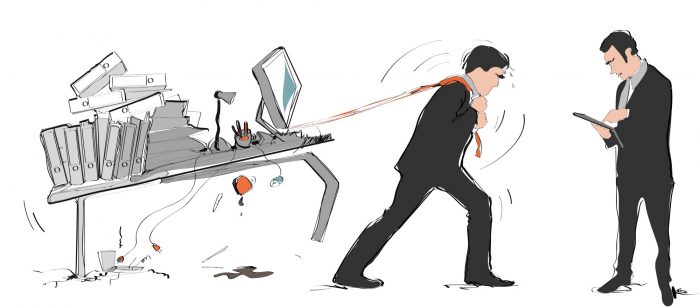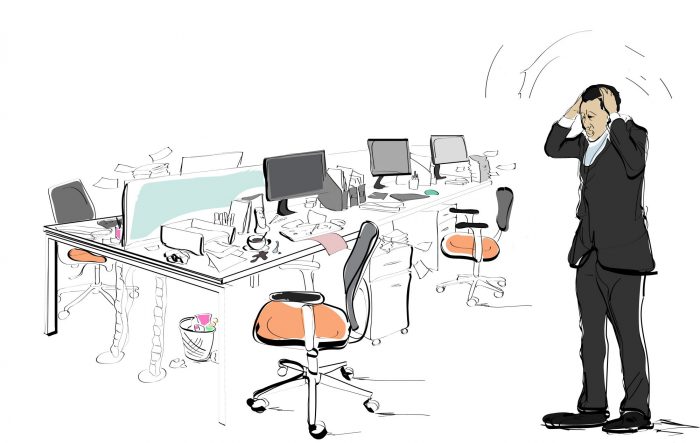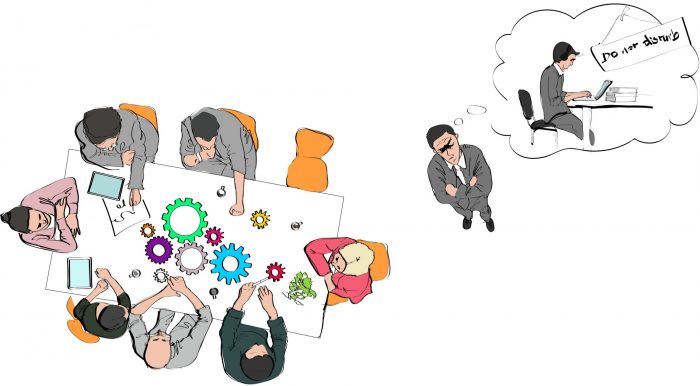With the traditional office lease in demise, Alison White of PLACEmaking looks at what is emerging as a replacement in terms of smarter working
Commercial letting agents are reporting the rapid demise of the conventional office lease and the increase in demand for more flexible terms and altogether new workspace solutions. With the trend growing for businesses to temporarily contract resources to cope with changing volumes of workload plus the outsourcing of specialist content, the days of predictable office space requirements based on a static headcount is over. As a result, in place of long-term commitment to ever-increasing rent rises and skyrocketing service charges, new solutions are being sought that allow organisations to be nimbler, flexing in response to the consequences of political and economic uncertainty but also increased acceptance of newer, smarter ways of working.
Working remotely and workspaces
The typical working week has been changing for some time. In place of Monday to Friday, Monday to Thursday has become increasingly common with “work-where-you-like” on a Friday and ad-hoc use of home and camping in high street cafes becoming the new norm, enabled by remote access to information and communications. As this pattern has matured, working remotely has expanded beyond just Fridays, with organisations becoming increasingly aware that the expense of providing underutilised space and services is unsustainable. Whilst in the past they would have assumed that if they can’t see their staff how would they know they were actually working; enlightened managers have recognised that productivity can’t be measured simply by presenteeism.
Many organisations are accepting that in place of imposing the misery of pointless commuting every day, they need to actively support their staff have a greater choice of where they work for at least part of their week. An appetite for new more flexible property solutions has emerged with businesses adopting a smaller footprint of their own core branded space with a distributed network of time charged serviced offices, local to where their resources live.

Whilst employer focused cost control pressures are inevitably fuelling the demand for more flexible property solutions, it is the significant change in our attitude to what ‘going to work’ means and workforce demands for a better work-life balance that underpins the momentum for a rethink in where and in what sort of environments we want to work. Whilst in some places there is an on-going battle still raging about what’s the best office solution either open-plan or cellular solutions, the reality is physically going to the ‘office’ is rapidly becoming less of a daily necessity and more just one of many options.
Such options have expanded beyond the simple alternatives to the office, i.e. just home or the local coffee shop to now include independently owned and operated workplace ‘clubs’. Unlike the ‘serviced office’ providers that have been around for some time, new providers are delivering a fresher new offer. Paid for on monthly subscription, these workspaces offer characterful places in contrast to the ‘vanilla’ serviced offices of the past. Where once these new ‘funky solutions’ were regarded as relevant only to the start-up tech and creative industries and even for them a passing fad, these new clubs are attracting a wider range of users because of their warm, friendly, contemporary styled modern mix of eclectic interiors with exceptional technology, connectivity and service infrastructure.
The trend for using these solutions has expanded into more of the mainstream and enterprises of all sizes and shapes now regard them as a legitimate part of their broader accommodation solution. Whilst some may regard ‘cute’ co-working clubs filled with the ubiquitous whiff of fresh coffee and inevitable table football machine as a bit of a cliché relevant to the ‘snowflake’ generation, many of the subscription users of such places are in fact full-time mainstream corporate businesses staff or their specialist contractors.
What’s the attraction and what’s the risk?
It’s not difficult to appreciate the tangible financial benefits of reducing the traditionally leased office to a minimum supplemented by these flexible office clubs. In terms of attraction to the individual though, it’s more complex. In part, the attraction is avoiding unnecessary commuting and avoiding the frequently reported loneliness and isolation when working from home but it’s more than that, it’s about being part of something that the corporate office rarely if ever achieves. It’s about stimulation, inspiration and motivation and most importantly, unlike when confined to a single employer-owned office, if you don’t feel you’re getting what you want from one workplace, you can simply end your subscription and move on the next one. Institutional office politics don’t apply in these places either which means, however, senior or junior your grade, everyone has the same rights and behavioural obligations. Employees of one organisation co-work quite happily alongside others, from the large and long-established organisations to minnow brand new enterprises, all without the physical boundaries of walls or management constraints.
Why people prefer these informal workspaces
Listen carefully to why people prefer these informal workspaces to their employer’s offices, and they include:
- Ease of access, avoiding commuting;
- Stimulating environment, like-minded co-workers;
- Enterprising culture;
- Informal atmosphere, dress code, attitude;
- Contemporary design;
- Modern food, art, music offer;
- Lack of corporate stamp;
- Emphasis on a characterful environment;
- Technologies that work;
- No hierarchy and office politics;
- They’re just happier when they’re there.
Importantly, it’s the function of these place to facilitate co-working: to encourage interaction between individuals and across organisations, which, in turn, supports a greater collaboration and shared enterprise that results in innovative thinking which, in turn, benefits everyone if they are prepared to take advantage of emerging opportunities. New behaviours are emerging.
There is a risk. It’s relatively easy to conceive and deliver new solutions when your business is just starting out and the canvass is blank, but demonstrating a willingness and responsiveness to new challenges and navigating through such changes in more well-established organisations does have its challenges. Limping on with out-dated workplace solutions might have appeared to be a savvy economic saving but now the design and functionality of the workspace offer are regarded as a key expression of an organisations intention to stay relevant and competitive, rendering such savings as short-sighted.

Behavioural change
Whilst turning the ‘big ship’ that is the property market to respond to these emerging demands for different workspace solutions to what the market has spent decades delivering, the importance of the physical PLACE is not diminishing, but it is different as PLACEmaking explored in ‘Do we really need to build any more office buildings” (https://www.placemaking.co.uk/do-we-really-need-to-build-any-more-office-buildings/).
For well-established businesses, rethinking their workplace solutions and implementing wider participation in smart working, encouraging remote working and, in turn, reducing their owned office portfolio requires balancing the contemporary demands of targeted recruits along with the expectations of an existing workforce. Whilst focusing on recruitment messaging is important, hanging on to those high- value recruits beyond the initial honeymoon period and retaining key resources within the existing workforce is essential. This is best achieved by creating opportunities to mesh new initiatives and approaches with the best of existing behaviours, leaving behind those no longer relevant. Unsympathetically addressed, attempts to adapt long-established behaviours can be destabilising and a distraction for the business, often resulting in unnecessary negativity towards the engagement process itself, if not conflict towards the vision and business objectives driving news workplace initiatives.
Many aspects of change appear complex and indeed they are. Some are so rooted in tradition and so established in the norms of day-to-day activities that even the notion of challenging their continued existence can appear somewhat illogical. Yet if smart ways of working are to be successfully adopted, then some embedded behaviours must be challenged.
Two examples spring to mind. One of which must be the routine, weekly one-hour meeting. With instant access to business-related performance data and immediate, reliable low-cost video communications connecting people, however, remote their location, the continued pattern of routinely bringing people together, often in uninspiring meeting rooms, sparsely furnished, poorly ventilated and lacking any modern technologies to assist insist paperless information sharing is a mystery and a misery to many.
Do we need meetings?
So why do we keep arranging and attending them? Recent media coverage set out Elon Musk’s views on pointless meeting (https://www.placemaking.co.uk/take-elon-musks-lead-just-walk-bad-meetings/) highlighted how quickly behaviours can become entrenched even when the purpose of them is sometimes lost. Compare the landscape of a typical corporate office full of static meeting rooms with what’s on offer in office ‘clubs’ where the emphasis is on connectivity, spontaneous discussion and speedy decision making. There the emphasis is on speed and connectivity: modern, informal, interactive collaboration spaces are all comms and technology-enabled, encouraging spontaneous interaction, problem-solving and speedy decision making.

Communication – the prevalence of emails
The second example is how people communicate and specifically, the behaviours associated with email, dependency on it as a tool has become entrenched in many organisations. Most users have a love/hate relationship with email but for long-established organisations, there’s no obvious absolute replacement. Whilst we now carry around our cable-free computing devices and the very purpose of smart working is to support new ways of working that reduces administrative tasks and increase creative innovation, some behaviours associated with emails assume receivers have nothing better to do than instantly read and reply to emails.
The use of email can be so invasive that individuals dread going on holiday not because they’d rather be working than enjoying some carefree time with friends and family – but because they know that their first few days back will be spent sifting through hundreds of pointless emails jammed into their inbox searching for the odd one that is actually important and they must ‘file’.
By rejecting inflexible property leases on uninspiring office buildings and interiors and pursuing alternative solutions, pioneering businesses including those that are start-ups or more established are not just choosing a different workplace solutions, they are signalling they intend to operate in a completely new way and demonstrating how business is transacted with and between them will be altogether different going forward: reflecting modern demands to embrace new codes of behaviour and a better balance of personal and professional expectations.
Aligning support services with smart ways of working
Adapting embedded behaviours and transforming traditional workplace solutions in line with smart working is made difficult, if not impossible where established HR policies and support service practices are not fully aligned. In established organisations, these services have evolved to efficiently and effectively service and support the status quo and so it’s inevitable they can be at odds with the changes a leadership team must lead if their organisations are to adopt smart working and stay relevant and attractive to the best talent. Some examples of where these support services need to change include:
Human resources (HR)
One people focused change is the meaning of the words ‘manage’ and ‘manager’. Both need new definitions when presenteeism and eye-to-eye contact no longer applies. Smarter ways of working demands and enables the development of new innovation skills in place of the past emphasis on multiple layers of management.
A greater emphasis is now on data analysis, problem-solving, individual responsibility and judgment, increased focus on sharing experience and knowledge, relationship building, cross organisation collaboration and active communication.
As teams and individuals work remotely, in place of the command and control structures of the past, a greater emphasis is needed on engagement and developing a culture of commitment and enterprise to achieve objectives through consensual team charters and the non-hierarchical sharing of challenges, targets and rewards.
Facilities management (FM)
A key support service that has too often measured by cost rather than the quality of service delivery. Smarter ways of working will make more and different demands on FM broadening the focus beyond fixed asset, cost-driven building services and maintenance to a greater and more active facilitation of customer service delivery. With reduced scale and scope of services focused on traditional property assets, higher valued ‘people’ focused services will need to emerge, offering greater levels of virtual support for remote working in places operated by others and the servicing of increased value and performing assets, but in a reduced scale of facilities and assets and in a wider range of remote physical environments. Fundamentally the specification of service level agreements (SLA’s) and pricing mechanisms for this enhanced service can no longer be based on a square footage charge but increasingly on quality of outputs and results of its customers and the service they, in turn, deliver to the end users.
ICT
Another key support service, all too often constrained in the delivery of narrow, cost-driven and multiple threshold based delivery solutions that somehow consistently miss user expectations. Often encapsulated in technical jargon that as a result, reduces the value of the vital tools and service required and undervalues the supply and maintenance of core services which overall results in a disconnection from the service and the human resources that are intended to exploit the technical solutions on offer.

Alison White
Co-Founder








Thank you for sharing with us….